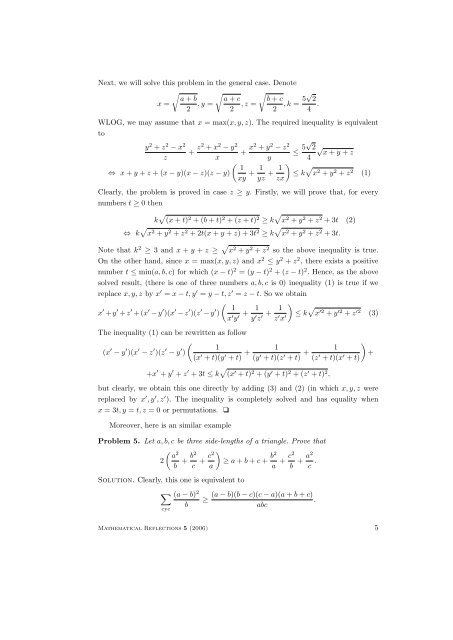The entirely mixing variables method
The entirely mixing variables method
The entirely mixing variables method
Create successful ePaper yourself
Turn your PDF publications into a flip-book with our unique Google optimized e-Paper software.
Next, we will solve this problem in the general case. Denote<br />
√ √ √<br />
a + b a + c b + c<br />
x =<br />
2 , y = 2 , z = 2 , k = 5√ 2<br />
4 .<br />
WLOG, we may assume that x = max(x, y, z). <strong>The</strong> required inequality is equivalent<br />
to<br />
y 2 + z 2 − x 2<br />
+ z2 + x 2 − y 2<br />
+ x2 + y 2 − z 2<br />
≤ 5√ 2√ x + y + z<br />
z<br />
x<br />
y 4<br />
( 1<br />
⇔ x + y + z + (x − y)(x − z)(z − y)<br />
xy + 1<br />
yz + 1 )<br />
≤ k √ x<br />
zx<br />
2 + y 2 + z 2 (1)<br />
Clearly, the problem is proved in case z ≥ y. Firstly, we will prove that, for every<br />
numbers t ≥ 0 then<br />
k √ (x + t) 2 + (b + t) 2 + (z + t) 2 ≥ k √ x 2 + y 2 + z 2 + 3t (2)<br />
⇔ k √ x 2 + y 2 + z 2 + 2t(x + y + z) + 3t 2 ≥ k √ x 2 + y 2 + z 2 + 3t.<br />
Note that k 2 ≥ 3 and x + y + z ≥ √ x 2 + y 2 + z 2 so the above inequality is true.<br />
On the other hand, since x = max(x, y, z) and x 2 ≤ y 2 + z 2 , there exists a positive<br />
number t ≤ min(a, b, c) for which (x − t) 2 = (y − t) 2 + (z − t) 2 . Hence, as the above<br />
solved result, (there is one of three numbers a, b, c is 0) inequality (1) is true if we<br />
replace x, y, z by x ′ = x − t, y ′ = y − t, z ′ = z − t. So we obtain<br />
( 1<br />
x ′ + y ′ + z ′ + (x ′ − y ′ )(x ′ − z ′ )(z ′ − y ′ )<br />
x ′ y ′ + 1<br />
y ′ z ′ + 1 )<br />
z ′ x ′ ≤ k √ x ′2 + y ′2 + z ′2 (3)<br />
<strong>The</strong> inequality (1) can be rewritten as follow<br />
(<br />
(x ′ − y ′ )(x ′ − z ′ )(z ′ − y ′ )<br />
1<br />
(x ′ + t)(y ′ + t) + 1<br />
(y ′ + t)(z ′ + t) + 1<br />
(z ′ + t)(x ′ + t)<br />
+x ′ + y ′ + z ′ + 3t ≤ k √ (x ′ + t) 2 + (y ′ + t) 2 + (z ′ + t) 2 ,<br />
)<br />
+<br />
but clearly, we obtain this one directly by adding (3) and (2) (in which x, y, z were<br />
replaced by x ′ , y ′ , z ′ ). <strong>The</strong> inequality is completely solved and has equality when<br />
x = 3t, y = t, z = 0 or permutations. ❑<br />
Moreover, here is an similar example<br />
Problem 5. Let a, b, c be three side-lengths of a triangle. Prove that<br />
( ) a<br />
2<br />
2<br />
b + b2 c + c2 ≥ a + b + c + b2<br />
a<br />
a + c2 b + a2<br />
c .<br />
Solution. Clearly, this one is equivalent to<br />
∑ (a − b) 2<br />
≥<br />
b<br />
cyc<br />
(a − b)(b − c)(c − a)(a + b + c)<br />
.<br />
abc<br />
Mathematical Reflections 5 (2006) 5
















